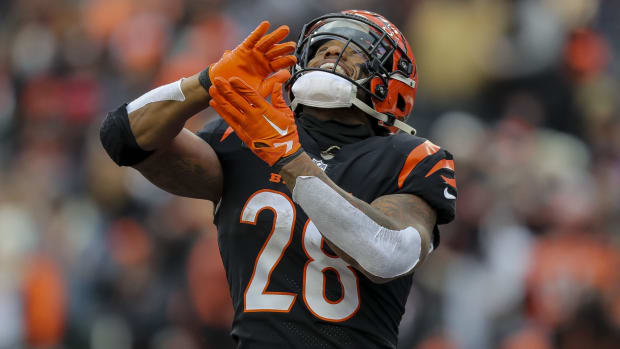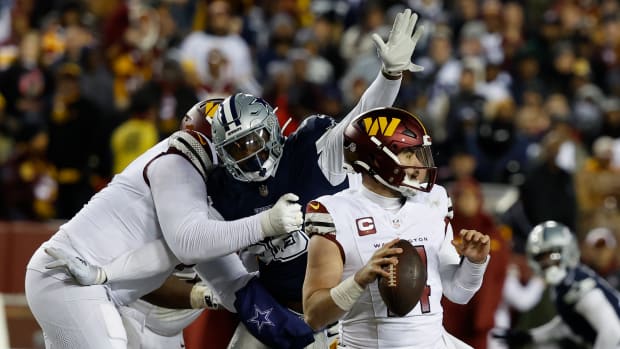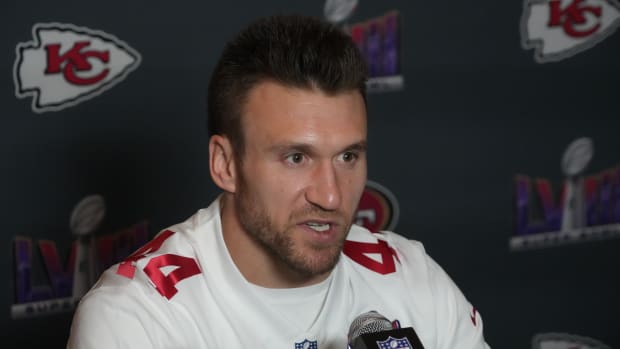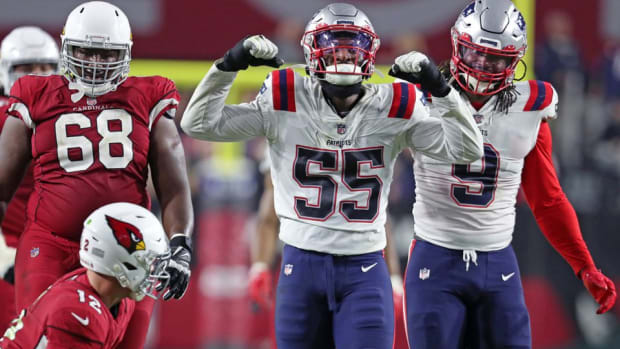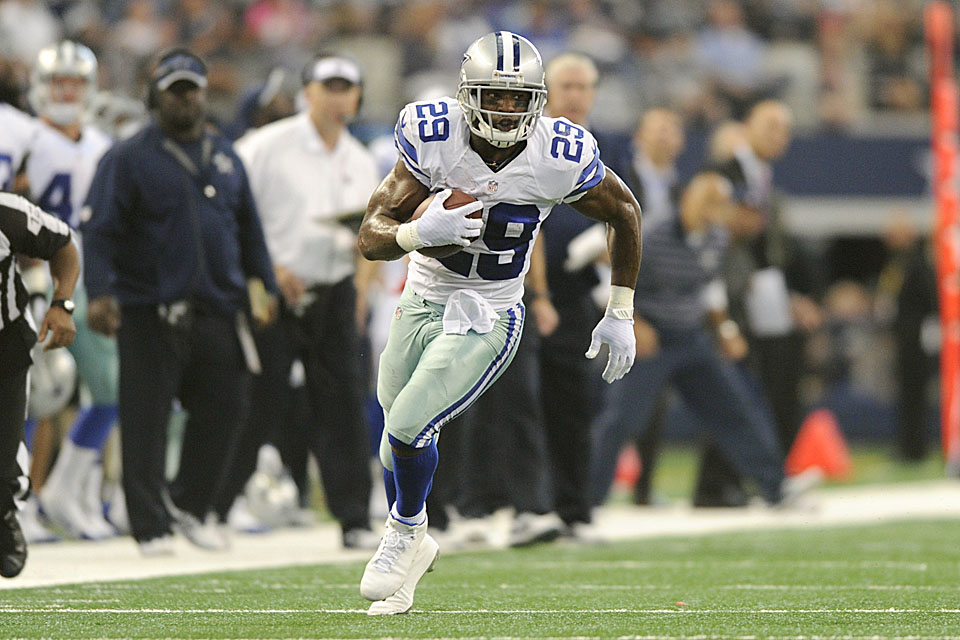
DeMarco's Costly Run
DeMarco Murray is one of the pleasant surprises of the season’s first half, with an astounding 913 yards gained. He’s also fodder for an interesting discussion in the business of football. On the field, he has become everything the Cowboys hoped he would become: a dependable workhorse running back challenging defenses and opening up the passing game. Off the field, his expiring contract sparks a debate regarding his present and future value.
Murray’s production illustrates the tricky intersection between a running back’s early-career success and concern over wear and tear. It is inverse to the norm. If we were discussing a player at any other position, prolific production in a contract year would be a major leverage point and a lead item on the résumé of accomplishments. For a running back, however, that fact can be, and often is, used as a negative rather than a positive in contract negotiations. Indeed, one can safely ask this question: Is Murray’s impressive workload and success truly helping his contract drive or is it potentially hurting him?
Let’s examine...
Short Shelf Life
Front offices in all sports are schooled in planning ahead rather than being a prisoner of the moment. Team contract negotiators are now well versed in the principle of paying for future production rather than past performance. This has become especially true with running backs.
With the shortest shelf life of all NFL positions, management knows a running back’s end of the line comes earlier in the career arc than other positions. There is data to prove it, with a graveyard of bad second and third contracts given to running backs such as Eddie George, Jamal Anderson, Corey Dillon, Shaun Alexander and Edgerrin James to name a few. More recently, top-of-market deals given to players such as Chris Johnson, Michael Turner and Steven Jackson have proven to be poor investments.
I wondered if maybe, just maybe, Gurley allowed himself to get caught, thereby preserving shelf life for the NFL.
The 2014 free agent running back market illustrated the trend. The player receiving the most guaranteed money was Toby Gerhart ($4.5 million from Jacksonville), who had 36 carries last season. In contrast, Knowshon Moreno, who had 242 carries with the Broncos last year, could only manage a one-year, $2.7 million deal with the Dolphins (and he’s now out for the year with an ACL injury).
Jerryu2019s New World
In two years the Dallas Cowboys will move their headquarters to Frisco, Texas, where Tony Romo & Co. will share the facilities with local high school teams. It’s all part of Jerry Jones’ vision of marrying America’s team with Friday night lights. FULL STORY
While it’s clear that last year’s free agent class did not feature the best talent, the trend is clear. And while two of the league’s top backs, Jamaal Charles and Marshawn Lynch, were rewarded with years remaining on their contracts, a closer look inside those deals shows they were one-year adjustments, not new deals. The Chiefs and Seahawks cooled potential problems with short-term “upgrades” ($4.5 million for Charles, $1.5 million for Lynch) while adding no future guaranteed funds. Translation: They addressed temporary dissatisfaction from valuable short-term players without exposing risk or impeding their ability to “get out” in the future.
Players and agents of running backs routinely point to older running backs who thrived into their 30s, but the list is not long. Emmitt Smith and Curtis Martin are the exceptions, not the rule. And a wish—that older running backs continue their production—is not a plan.
No Green for Green
I was in this situation during my time with the Packers, when Ahman Green was as productive as any running back in the NFL. We rewarded him early in his career with a five-year contract extension, but as that contract reached its later years, Ahman and his agent saw an enhanced market for top backs and started expressing low rumbles of discontent.
As a friend of Ahman’s I was personally conflicted, but as a steward for the Packers I had to avoid an emotional reaction to his prolific performance of the moment and take a detached and analytical view on projected future performance. We let Ahman go to free agency, where he found the market he was seeking. He struck a deal with the Texans, one that was terminated following a couple of injury-plagued seasons.
A Tough Position
Perhaps it is the former agent in me, but I truly feel for running backs, the most disadvantaged of any NFL position group. Their peak performance years are prior to playing professionally, when they are not paid, or in early years of their NFL careers, when their pay is fixed at reasonable rates. And when it’s time to negotiate free agent contracts or extensions, teams minimize and/or negate previous success with a “tread on the tire” argument, hesitant to sink significant guaranteed funds into even second contracts, let alone third ones.
The recent suspension of the nation’s top collegiate running back, Georgia’s Todd Gurley for selling autographs to a memorabilia dealer, actually makes me wonder whether a diabolically clever business plan was hatched. Before his application for reinstatement was filed, I wondered if maybe, just maybe, Gurley (and an agent) allowed himself to get caught and be removed from play, thereby preserving shelf life for the NFL. His next 300 or so carries would not have been done for free; they would have been as a paid employee of an NFL team next fall. It’s highly unlikely that this was the case, but it raised my business of football antennae. And as NCAA players discuss unionization, I have thought that running backs should discuss a subgroup of their own.
Whither Murray?
Murray is a shining example of everything discussed above. We now must wonder if his historic statistical start is helping his drive for a top-level contract or, in actuality, detracting from it.
The Unknown Dallas D
The Cowboys have been the season’s biggest surprise, and much of it is due to the outstanding play of a unit devoid of big names and expectations entering 2014. FULL STORY
In the end, however, Murray might have a lifeline, and it’s his owner. Jerry Jones has shown a history of rewarding players with whom he has become enamored, even at relatively advanced ages. To wit, in 2011 Jones tore up existing contracts, with two years remaining on each, of veterans Jay (now known as Jeremiah) Ratliff and Jason Witten. Both were at or on the cusp of age 30, and both received sparkling new deals with $18 million of guaranteed money. And, of course, Tony Romo—someone Jones has become close with over the past decade—is now leveraged with the most mortgaged contract in the NFL, ensuring his presence on the team for at least three more years. Despite his fondness for Romo, Jones admitted he had to be restrained from drafting Johnny Manziel, in what would have been the ultimate emotional decision.
Thus, despite the data points and concerns about rewarding running backs with high production and advancing age, Murray may be blessed by being on the right team with the right owner at the right time and the right place.
Stay tuned…
Harvin the Jet
And now Five Things I think about Seattle trading Percy Harvin to the Jets…
1. I often say the NFL is not a democracy, and greater talent equals greater tolerance. However, there are limits. Harvin’s dynamic abilities were not enough to balance issues that he brought beyond the field.
2. John Schneider and Pete Carroll are known as a general manager and a coach willing to look past character flaws; both have dealt with high-maintenance players before. Harvin must truly be a handful to deal with. The fact that they received only a sixth-round pick as compensation tells me that, absent a trade, they would have released him.
3. This is not a case of either Schneider or Jets GM John Idzik “getting over” on each other. They have worked together and understand the importance of relationships in this small world. Idzik knows exactly what he’s getting, for better or worse.
4. As for the Jets, they take on $6.47 million guaranteed for this year but nothing guaranteed after that. And the Seahawks will have a $7.2 million cap number for Harvin next year, as his name will linger there through another year (at least on the cap roster).
5. Normally in an in-season trade, the acquiring team would take on the salary for that week. However, the Jets, having played Thursday night, had already played their game before the deal was finished on Friday. Thus, the Seahawks are on the hook for Harvin’s weekly $647,000 salary, another benefit for the Jets.
[widget widget_name="SI Newsletter Widget”]




































